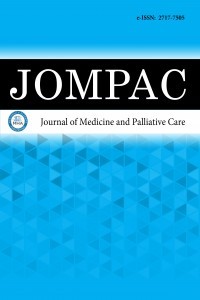Hastanede yatan COVID-19 hastalarında hastalığın ilerlemesini ve mortalite riskini tahmin etmede ETCO2 değerlerinin kullanılabilirliği
yoğun bakım ünitesi, mortalite, acil servis, COVID-19,
The utility of ETCO2 value in predicting the progress of the disease and mortality risk in hospitalized patients with COVID-19 pneumonia
COVID-19, intensive care unit, mortality, emergency medicine,
___
- Perlman S. Another decade, another coronavirus. N Engl J Med 2020; 382: 760-2.
- Zhang T, Wu Q, Zhang Z. Probable Pangolin Origin of SARS-CoV-2 Associated with the COVID-19 outbreak. Curr Biol 2020; 30: 1578.
- Sun S, Cai X, Wang H, et al. Abnormalities of peripheral blood system in patients with COVID-19 in Wenzhou, China. Clin Chim Acta 2020; 507: 174-80.
- Kermali M, Khalsa RK, Pillai K, Ismail Z, Harky A. The role of biomarkers in diagnosis of COVID-19 – A systematic review. Life Sci 2020; 254: 117788.
- Gattinoni L, Coppola S, Cressoni M, Busana M, Rossi S, Chiumello D. COVID-19 does not lead to a “typical” acute respiratory distress syndrome. Am J Respir Crit Care Med 2020; 201: 1299-300.
- Liu X, Liu X, Xu Y, et al. Ventilatory ratio in hypercapnic mechanically ventilated patients with COVID-19-associated acute respiratory distress syndrome. Am J Respir Crit Care Med 2020; 201: 1297-9.
- Pan C, Chen L, Lu C. Lung recruitability in COVID-19-associated acute respiratory distress syndrome: a single-center observational study. Am J Respir Crit Care Med 2020; 201: 1294-7.
- Henderson WR, Chen L, Amato MBP, Brochard LJ. Fifty years of research in ARDS. Respiratory mechanics in acute respiratory distress syndrome. Am J Respir Crit Care Med 2017; 196: 822-33.
- Xia J, Feng Y, Li M, et al. Increased physiological dead space in mechanically ventilated COVID-19 patients recovering from severe acute respiratory distress syndrome: a case report. BMC Infect Dis 2020; 20: 637.
- Kallet RH, Lipnick MS. End-tidal-to-arterial PCO2 ratio as signifier for physiologic dead-space ratio and oxygenation dysfunction in acute respiratory distress syndrome. Respir Care 2021; 66: 263-8.
- Kallet RH, Daniel BM, Garcia O, Matthay MA. Accuracy of physiologic dead space measurements in patients with acute respiratory distress syndrome using volumetric capnography: comparison with the metabolic monitor method. Respir Care 2005; 50: 462-7.
- Doorduin J, Nollet JL, Vugts MP, et al. Assessment of dead-space ventilation in patients with acute respiratory distress syndrome: a prospective observational study. Crit Care 2016; 20: 121.
- Sinha P, Calfee CS, Beitler JR, et al. Physiologic analysis and clinical performance of the ventilatory ratio in acute respiratory distress syndrome. Am J Respir Crit Care Med 2019; 199: 333-41.
- Gattinoni L, Chiumello D, Rossi S. COVID-19 pneumonia: ARDS or not? Crit Care 2020; 24: 154.
- Field JM, Hazinski MF, Sayre MR, et al. Part 1: Executive summary: 2010 American Heart Association Guidelines for Cardiopulmonary Resuscitation and Emergency Cardiovascular Care. Circulation 2010; 122: 640-56.
- Cereceda-Sánchez FJ, Molina-Mula J. Capnography as a tool to detect metabolic changes in patients cared for in the emergency setting. Rev Lat Am Enfermagem 2017; 25: e2885.
- Aminiahidashti H, Shafiee S, Zamani Kiasari A, Sazgar M. Applications of end-tidal carbon dioxide (ETCO2) monitoring in emergency department; a narrative review. Emerg (Tehran) 2018; 6: e5.
- EMS Products. https://www.ems1.com/ems-products/capnography/articles/etcO2-monitoring-youre-doing-the-right-thing-2WyB2s4MXPgA2Lw7/. Nowak T. Accessed 18 February 2021.
- Hu D, Li J, Gao R, et al. Decreased CO2 Levels as indicators of possible mechanical ventilation-induced hyperventilation in COVID-19 patients: a retrospective analysis. Front Public Health 2021; 8: 596168.
- The Turkish Ministry of Health (2020) Guidelines for the Management of Adults with COVID-19. https://covid19bilgi.saglik.gov.tr/depo/rehberler/COVID-19-Rehberi.pdf. Accessed 11 Januray 2021.
- Robertson HT. Dead space: the physiology of wasted ventilation. Eur Respir J 2015; 45: 1704-16.
- Nuckton TJ, Alonso JA, Kallet RH, et al. Pulmonary dead-space fraction as a risk factor for death in the acute respiratory distress syndrome. N Engl J Med 2002; 346: 1281-6.
- Mauri T, Spinelli E, Scotti E, et al. Potential for lung recruitment and ventilation-perfusion mismatch in patients with the acute respiratory distress syndrome from coronavirus disease 2019. Crit Care Med 2020; 48: 1129-34.
- Tang Y, Turner MJ, Baker AB. Effects of alveolar dead-space, shunt and V/Q distribution on respiratory dead-space measurements. Br J Anaesth 2005; 95: 538-48.
- Zhou F, Yu T, Du R, et al. Clinical course and risk factors for mortality of adult in patients with COVID-19 in Wuhan, China: A retrospective cohort study. Lancet 2020; 395: 1054-62.
- Albarello F, Pianura E, Di Stefano F, et al. 2019-novel coronavirus severe adult respiratory distress syndrome in two cases in Italy: An uncommon radiological presentation. Int J Infect Dis 2020; 93: 192-7.
- Anderson CT, Breen PH. Carbon dioxide kinetics and capnography during critical care. Crit Care 2000; 4: 207-15.
- Chinese Clinical Guidance for COVID-19 Pneumonia Diagnosis and Treatment. 7th ed. http://kjfy.meetingchina.org/msite/news/show/cn/3337.html. China national health commission. Accessed 25 February 2021.
- Başlangıç: 2020
- Yayıncı: MediHealth Academy Yayıncılık
Aysun KARSLI, Sinan Oğuzhan ÖZSAN, Ertan COMERTPAY, Ahmet Faruk BAŞKÜRKÇÜ, Oğuz EROĞLU, Turgut DENİZ
Metin ÖZSOY, Şebnem ERDİNÇ, Salih CESUR, Gunay TUNCER ERTEM, Cigdem ATAMAN HATİPOGLU, Sami KINIKLI
İmmünglobülin G4 ilişkili hastalıkta nüksü etkileyen faktörler: retrospektif bir analiz
Müge AYDIN TUFAN, Derya KAŞKARİ
Pediatrik palyatif bakımda yaşam sonu bakım kavramı
Şanlıay ŞAHİN, Fatma Zehra ÖZTEK ÇELEBİ, Ganime AYAR
Diş hekimliğinde esansiyel yağların kullanımı
Çağla YANKI, Meltem HENDEK, Ebru OLGUN
Trombositten zengin fibrin ve diş hekimliğinde kullanımı
Sarah KHALED, Ebru OLGUN, Meltem HENDEK
Kronik pelvik ağrılı hastalarda laparoskopi sonuçlarının değerlendirilmesi
Asena AYAR MADENLİ, Halime ÇALI ÖZTÜRK
Pınar Yeşim AKYOL, Hüseyin ACAR, Rezan KARAALİ, Ejder Saylav BORA, Fatih TOPAL
